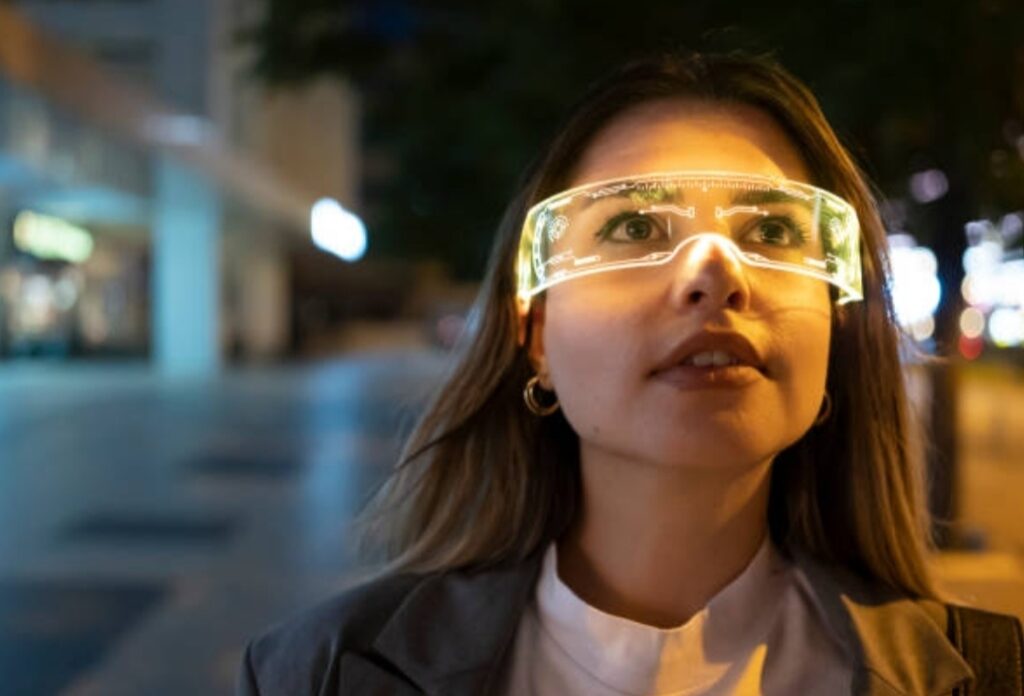What is a Smart Glasses? An Introduction to Wearable Technology
In today’s fast-paced digital world, wearable technology is reshaping how we interact with information, the internet, and even the physical world.
One of the most groundbreaking innovations in wearable technology is smart glasses—a futuristic device that brings augmented reality (AR), artificial intelligence (AI), and hands-free computing right in front of your eyes.
But what is a smart glasses?
At its core, smart glasses are eyewear devices equipped with advanced technology that enhances vision, provides real-time data, and allows users to interact with digital content in their physical surroundings.
They combine traditional eyewear functionality with high-tech features such as heads-up displays (HUDs), voice assistants, touch controls, and even AI-powered cameras.

The Evolution of Smart Glasses: From Sci-Fi to Reality
Just a decade ago, smart glasses seemed like a far-fetched idea from science fiction movies.
But today, they are becoming a reality with cutting-edge innovations from tech giants like Google, Apple, Meta, and Microsoft.
The concept of smart glasses first gained mainstream attention with Google Glass in 2013, a revolutionary but controversial attempt at creating AR-powered glasses.
Although Google Glass didn’t achieve mass adoption, it paved the way for modern smart glasses, influencing brands to refine and improve the technology.
Now, in 2025, smart glasses have evolved significantly, offering sleeker designs, enhanced processing power, improved AR overlays, and seamless integration with smartphones and cloud computing.
How Do Smart Glasses Work? The Technology Behind Them
Smart glasses function through a combination of advanced hardware and intelligent software.
Let’s break down how they work:
✅ Display Technology: Most smart glasses use Augmented Reality (AR) displays, micro-OLED screens, or waveguide optics to overlay digital content onto the real world.
Some models feature transparent lenses, while others use small projectors to beam images directly onto the user’s retina.
✅ Connectivity & Processing Power: These devices connect to Wi-Fi, Bluetooth, or 5G networks to stream real-time information.
Many smart glasses are powered by built-in microprocessors, similar to those found in smartphones and AI-driven computers.
✅ Voice & Gesture Controls: Modern smart glasses come equipped with voice assistants like Google Assistant, Siri, or Alexa, enabling users to control them hands-free.
Additionally, some models allow for gesture-based controls, where you can interact with digital content using hand movements.
✅ AI-Powered Cameras & Sensors: Many smart glasses feature high-resolution cameras with AI capabilities, allowing users to capture photos, record videos, and even recognize objects or translate languages in real time.
Advanced models also include LiDAR sensors, gyroscopes, and accelerometers to improve navigation and spatial awareness.
Why Are Smart Glasses Considered the Future of Wearable Technology?
Smart glasses are not just a cool tech gadget—they represent the next big leap in human-computer interaction.
Here’s why they are revolutionizing wearable technology:
🟢 Hands-Free Computing: Unlike smartphones, smart glasses allow users to access information, receive notifications, and interact with apps without using their hands.
🟢 Seamless AR Integration: With augmented reality overlays, smart glasses can enhance real-world experiences, from real-time navigation to interactive gaming and professional applications.
🟢 Productivity & Work Efficiency: Industries like healthcare, manufacturing, logistics, and engineering are adopting smart glasses to improve efficiency, streamline workflows, and enhance training experiences.
🟢 Enhanced Communication: Many smart glasses come with built-in microphones, speakers, and live-streaming capabilities, allowing for virtual meetings, hands-free calls, and real-time collaboration.
🟢 AI-Powered Personal Assistants: As AI technology advances, smart glasses are becoming more intuitive, offering context-aware recommendations, personalized notifications, and even predictive analytics.
Who Can Benefit from Smart Glasses?
Smart glasses cater to a wide range of users, including:
🔹 Professionals & Businesses: Doctors, engineers, and field workers use AR-powered smart glasses for real-time data visualization, remote assistance, and hands-free guidance.
🔹 Gamers & Tech Enthusiasts: With support for immersive AR gaming and entertainment, smart glasses offer next-level augmented reality experiences.
🔹 Everyday Consumers: From navigating busy cities to translating languages in real-time, smart glasses provide convenient, hands-free access to digital information.
🔹 People with Disabilities: AI-powered features like real-time object detection, voice assistance, and AR overlays help visually impaired users navigate their surroundings more safely.

The Challenges & Limitations of Smart Glasses
While smart glasses have incredible potential, they also face some challenges:
🔻 Battery Life Issues: Most smart glasses require frequent charging due to their high-power AR displays and AI functions.
🔻 Privacy Concerns: With built-in cameras and real-time facial recognition, there are serious concerns regarding surveillance and data privacy.
🔻 Expensive Price Tags: High-end smart glasses can cost $500–$3000, making them inaccessible to the average consumer.
🔻 Limited App Ecosystem: Unlike smartphones, smart glasses still have a relatively small number of apps, but this is expected to grow in the coming years.
Are Smart Glasses the Future?
As technology continues to advance, smart glasses are expected to become more mainstream, affordable, and feature-rich.
Companies like Apple, Meta, and Microsoft are heavily investing in next-generation AR glasses, paving the way for a future where smart glasses replace smartphones altogether.
If you’re looking for the best smart glasses available today, check out our Top Smart Glasses of 2025 Guide to find the latest and most innovative models!
💡 Want to stay ahead in the world of wearable tech? Bookmark this page and follow us for the latest updates on smart glasses and AR innovations! 🚀
Understanding Smart Glasses
In the ever-evolving landscape of wearable technology, smart glasses are emerging as one of the most innovative and transformative devices.
These high-tech eyewear solutions seamlessly integrate computer-powered displays, artificial intelligence, and augmented reality (AR) features into everyday glasses.
With enhanced functionality, smart glasses are designed to improve productivity, enable hands-free communication, and revolutionize how we interact with digital content.
But how do they work? And what features set them apart from traditional eyewear?
Let’s dive deep into the world of smart glasses and explore their features, functionality, and underlying technology.

Defining Smart Glasses: Features and Functionalities
What Are Smart Glasses?
Smart glasses are wearable computing devices designed to overlay digital information onto the real world.
They function as a bridge between the physical and digital realms, allowing users to access real-time data, receive notifications, navigate using augmented reality, and even interact with AI-driven virtual assistants.
Unlike regular eyeglasses, smart glasses incorporate cutting-edge technology such as:
✅ Heads-up displays (HUDs) for real-time information
✅ Augmented reality (AR) and mixed reality (MR) support
✅ AI-powered voice and gesture controls
✅ Live-streaming and video recording capabilities
✅ Wireless connectivity via Bluetooth, Wi-Fi, or 5G
These features enhance user experience by providing hands-free access to digital content, making smart glasses an essential tool for professionals, gamers, and everyday users.
Augmented Reality (AR) and Mixed Reality (MR) Capabilities
One of the biggest advantages of smart glasses is their ability to integrate augmented reality (AR) and mixed reality (MR) into daily life.
🟢 Augmented Reality (AR): Smart glasses with AR capabilities overlay digital content onto the real world, enabling users to see notifications, directions, or interactive elements in their field of vision.
Examples:
- Google’s AR glasses project real-time navigation onto the lenses.
- Microsoft HoloLens allows professionals to visualize 3D models in engineering and medicine.
🟢 Mixed Reality (MR): MR-capable smart glasses blend real-world and digital interactions, allowing users to manipulate 3D objects, interact with holograms, or engage in immersive experiences.
Examples:
- Meta’s AR smart glasses enable seamless integration between the real and virtual world.
- Magic Leap devices offer interactive experiences for gaming, remote work, and training simulations.
With AR and MR technology evolving rapidly, smart glasses are poised to revolutionize industries such as healthcare, gaming, education, and remote work.

How Do Smart Glasses Work?
Smart glasses function through a combination of advanced hardware, intelligent software, and cloud-based connectivity.
Let’s break down the core technologies that power these futuristic eyewear devices.
Core Technologies in Smart Glasses
🟢 Display Technology: Visualizing Digital Content
The display is the heart of smart glasses, allowing users to view digital information without looking at a separate screen.
Different models use various display technologies:
✅ Waveguide optics – Projects digital content onto transparent lenses
✅ Micro-OLED screens – Provide high-resolution augmented reality visuals
✅ Laser projection – Directs images onto the retina for ultra-clear visuals
Popular brands like Apple, Google, and Meta are investing in next-gen display technology to create more immersive and realistic AR experiences.
🟢 AI-Powered Voice and Gesture Controls
Most smart glasses feature voice assistants like Google Assistant, Siri, or Alexa, allowing for hands-free operation.
Additionally, gesture-based controls enable users to navigate menus, answer calls, or interact with AR elements using simple hand movements.
Examples of Gesture Controls:
👆 Swiping across the frame to scroll through menus
🖐️ Pinching fingers together to select an object in AR
🗣 Using voice commands to control smart glasses without touching them
🟢 Connectivity & Processing Power
To deliver real-time information, smart glasses rely on Wi-Fi, Bluetooth, and 5G networks.
Many models are powered by built-in microprocessors, allowing them to run apps, stream content, and process AI-driven tasks efficiently.
🟢 AI-Powered Cameras & Sensors
Many smart glasses are equipped with high-resolution cameras, depth sensors, and LiDAR technology.
These cameras allow users to
📸 Capture photos & record videos in real-time
🌍 Translate languages instantly using AI-powered recognition
👀 Enhance vision with night mode and object detection
Some advanced models, like Microsoft HoloLens, even use eye-tracking sensors to offer hands-free AR experiences.
Why Smart Glasses Are the Future
With advancements in AR, AI, and wearable computing, smart glasses are set to transform industries and daily life.
As more brands invest in AI-powered features, better displays, and seamless connectivity, smart glasses will become a must-have device for professionals and tech enthusiasts alike.
💡 Want to experience the best smart glasses on the market? Check out our Top Smart Glasses of 2025 Guide and discover the latest innovations in wearable tech! 🚀
Evolution of Smart Glasses
Smart glasses have come a long way from being a futuristic concept to a real-world innovation that is shaping the future of wearable technology.
The journey of smart glasses began decades ago, with early prototypes paving the way for today’s high-tech, AI-powered eyewear.
This section explores the history of smart glasses, highlighting major milestones and breakthrough models that have transformed this technology into what it is today.

A Brief History of Smart Glasses
The concept of computerized eyewear dates back much further than most people realize.
While modern smart glasses are packed with augmented reality (AR), AI-driven features, and real-time connectivity, their origins can be traced to early heads-up displays (HUDs) and wearable computing devices.
Below is a timeline of key developments in the evolution of smart glasses:
1960s – The Birth of Wearable Displays
🔹 1968 – The First AR Headset:
- Ivan Sutherland, a computer scientist, created the first-ever augmented reality headset, called the Sword of Damocles.
- This device superimposed digital graphics onto the real world but was bulky and impractical.
1980s – The First Wearable Computer Glasses
🔹 1984 – The Private Eye by Reflection Technology:
- One of the earliest attempts at wearable computing, the Private Eye, was a monocular display that projected digital text onto a lens.
🔹 1989 – The EyeTap by Steve Mann:
- Often called the “Father of Wearable Computing,” Steve Mann developed the EyeTap, a device that could capture real-world images and overlay digital data.
- This was a precursor to modern AR smart glasses.
1990s – Early Military and Industrial Use
🔹 1992 – The First Heads-Up Display (HUD) for Pilots:
- The US Air Force developed a HUD system that projected critical flight data onto pilots’ visors.
🔹 1997 – IBM and Wearable Computing:
- IBM introduced one of the first concepts of a wearable PC, hinting at the possibility of future smart glasses with computing power.
2000s – The Rise of AR and Commercial Development
🔹 2003 – MicroOptical’s Wearable Display Glasses:
- One of the first commercially available smart glasses, MicroOptical’s glasses featured a display in one lens but lacked AR capabilities.
🔹 2012 – Google Glass is Announced:
- Google unveiled Google Glass, the first widely recognized smart glasses featuring voice commands, a built-in camera, and a head-up display.
- Though ahead of its time, it faced privacy concerns and limited adoption.
2020s – AI-Powered, AR-Driven Smart Glasses
🔹 2021 – Ray-Ban Meta Smart Glasses (formerly Facebook View):
- Meta (formerly Facebook) partnered with Ray-Ban to launch fashionable smart glasses with voice control, AI assistance, and live streaming capabilities.
🔹 2023 – Apple Vision Pro & Advanced AR Smart Glasses:
- Apple introduced Vision Pro, an advanced AR and mixed reality headset.
- More companies, including Microsoft, Snap, and Lenovo, entered the smart glasses market.
With rapid advancements in AI, 5G, and AR, smart glasses are expected to become an essential part of daily life, much like smartphones today.

Notable Smart Glasses Models Over the Years
The smart glasses industry has seen major breakthroughs, with tech giants constantly innovating.
Here’s a look at some of the most influential smart glasses models that have shaped the industry.
Google Glass (2013 & 2017 – Present)
✅ Features:
- Hands-free voice control
- Built-in camera for photos & videos
- Display screen in the corner of the lens
- Google Assistant integration
✅ Why It’s Important:
- Google Glass was the first consumer-focused smart glasses.
- It laid the foundation for AI-powered, voice-controlled wearable devices.
- Though its consumer version failed, Google Glass Enterprise Edition was later launched for industrial applications.
Microsoft HoloLens (2016 & 2019 – Present)
✅ Features:
- Mixed reality (MR) capabilities
- Advanced 3D holographic visualization
- AI-powered object recognition
- Enterprise & professional applications
✅ Why It’s Important:
- HoloLens revolutionized AR smart glasses by offering true mixed reality.
- It is widely used in engineering, medicine, and remote work.
Ray-Ban Meta Smart Glasses (2021 – Present)
✅ Features:
- AI-powered voice assistant
- Live streaming & hands-free photo capture
- Stylish design in collaboration with Ray-Ban
- Direct integration with Meta (Facebook, Instagram, and WhatsApp)
✅ Why It’s Important:
- One of the first smart glasses designed for mainstream users.
- Offers social media-friendly features like live streaming & content creation.
Apple Vision Pro (2024 – Present)
✅ Features:
- High-resolution AR & MR experience
- Eye-tracking and hand gesture controls
- 3D interface with advanced AI
- Seamless integration with Apple ecosystem
✅ Why It’s Important:
- Apple’s entry into smart glasses and AR has set new standards for immersive experiences.
- It is expected to reshape the future of wearable computing.
The Future of Smart Glasses
From military HUDs to AI-powered AR glasses, smart glasses have evolved significantly over the decades.
Today, they are no longer just a futuristic concept but a practical tool for communication, productivity, and entertainment.
With tech giants like Apple, Google, Meta, and Microsoft investing heavily in AI-driven smart glasses, the future looks promising and limitless.
💡 Want to explore the best smart glasses for your needs?
Check out our Best Smart Glasses of 2025 Guide to find the perfect pair for work, gaming, and daily life! 🚀
Applications of Smart Glasses
Smart glasses are transforming the way we interact with technology, offering a seamless blend of digital and real-world experiences.
These futuristic devices are being integrated into everyday life, professional industries, and even specialized sectors, making them one of the most versatile pieces of wearable technology.
But what is a smart glasses, and how does it enhance our daily lives and industries?
Let’s explore how these cutting-edge devices are revolutionizing personal and professional experiences.

Smart Glasses in Everyday Life
Smart glasses are no longer just a sci-fi concept—they are now a practical tool for daily convenience.
From enhancing navigation and photography to offering real-time information and entertainment, smart glasses are changing the way people interact with digital content.
Here are some key consumer applications of smart glasses:
📍 Navigation & Travel
- No more staring at your phone for directions—smart glasses provide real-time navigation right in front of your eyes.
- Whether you’re walking, biking, or driving, AR-powered navigation overlays street names, arrows, and landmarks to guide you effortlessly.
- Some models, like the Vuzix Blade or Ray-Ban Meta Smart Glasses, even provide spoken turn-by-turn directions for hands-free convenience.
📸 Hands-Free Photography & Video Recording
- Capture moments instantly with built-in cameras in smart glasses.
- Devices like the Ray-Ban Stories or Snap Spectacles let you record POV (point-of-view) videos or take pictures without pulling out a phone.
- Ideal for travelers, vloggers, and adventure seekers, smart glasses provide an immersive way to document experiences without distractions.
🎧 Music & Entertainment
- Imagine listening to music or taking calls without blocking your ears—smart glasses with built-in bone conduction audio or open-ear speakers offer an immersive yet situationally aware experience.
- Some models allow users to stream music, watch videos, or even display subtitles for foreign language content.
📲 Real-Time Information Display
- Stay updated with instant notifications, messages, and weather updates displayed in your line of sight.
- Athletes and fitness enthusiasts can track their performance metrics, heart rate, or running pace in real time.
- AR-powered smart glasses can overlay real-time translations, making them an excellent tool for travelers in foreign countries.
🛍️ Augmented Reality Shopping & Virtual Try-Ons
- Try on clothes, accessories, or even furniture in your space before buying, thanks to AR-powered smart glasses.
- Retail giants like Amazon and IKEA are exploring smart glasses applications for virtual shopping experiences.
📌 Smart glasses are redefining everyday convenience, allowing users to interact with the digital world in a more immersive and efficient way!

Industrial and Professional Uses of Smart Glasses
While smart glasses offer entertainment and convenience for consumers, their impact on professional industries is even more groundbreaking.
From healthcare and manufacturing to logistics and education, smart glasses are revolutionizing productivity, efficiency, and safety in various sectors.
🏥 Healthcare & Medical Industry
- Surgeons use AR-powered smart glasses to access real-time patient data, MRI scans, and even live surgical guidance without looking away from the operating table.
- Telemedicine is becoming more efficient, allowing doctors to diagnose patients remotely through smart glasses with built-in cameras and AR overlays.
- First responders and paramedics can receive critical patient information while performing life-saving procedures on the go.
🏭 Manufacturing & Industrial Work
- Assembly line workers and engineers use smart glasses to access blueprints, step-by-step instructions, and hands-free manuals.
- Factory inspections and equipment maintenance become easier with AR overlays that highlight defects or necessary repairs in real time.
- Remote expert support allows technicians to troubleshoot machinery with real-time guidance through smart glasses.
📦 Logistics & Warehousing
- Smart glasses streamline warehouse operations by guiding workers to the correct inventory locations and optimizing pick-and-pack efficiency.
- Companies like DHL and Amazon have implemented smart glasses for hands-free barcode scanning and inventory management.
🏗️ Construction & Architecture
- Architects and engineers use smart glasses to visualize 3D building designs in real-world settings, improving project accuracy and efficiency.
- On-site workers can overlay digital construction plans onto physical environments, reducing errors and enhancing safety.
📚 Education & Training
- Smart glasses create immersive learning experiences for students, offering virtual field trips, 3D educational models, and real-time tutoring.
- Workplace training programs use AR-powered glasses to provide step-by-step guidance in industries like aviation, medicine, and automotive repair.
📌 The integration of smart glasses into professional sectors is accelerating, proving that these devices are not just a tech gadget but a transformative tool for modern industries!
Final Thoughts on Smart Glasses Applications
Smart glasses are revolutionizing both personal and professional experiences, making digital interaction more immersive, efficient, and futuristic.
Whether you’re a tech enthusiast looking for an innovative gadget or a business leader aiming to improve workplace efficiency, smart glasses are set to become an essential tool in the modern digital landscape.
📌 Are you ready to experience the power of smart glasses?
🔎 Explore the Best Smart Glasses for 2024 and upgrade your digital lifestyle today! 🚀
Advantages and Challenges of Smart Glasses
Smart glasses are revolutionizing the way we interact with technology, offering a hands-free, immersive experience that enhances both personal and professional productivity.
However, like any emerging technology, smart glasses come with their own set of challenges, including privacy concerns, cost, and hardware limitations.
In this section, we will explore the key benefits and drawbacks of smart glasses, helping users make informed decisions about this advanced wearable technology.

Benefits of Using Smart Glasses
Smart glasses are not just a gimmick or futuristic accessory—they offer real-world advantages that enhance productivity, accessibility, and entertainment.
Here’s a closer look at the major benefits of smart glasses:
Hands-Free Operation for Maximum Convenience
✅ Unlike smartphones or tablets, smart glasses allow users to interact with digital content without using their hands.
✅ Whether you’re a professional, student, or gamer, hands-free operation enables multitasking and efficiency like never before.
✅ Industries like healthcare, logistics, and engineering benefit from hands-free access to real-time data, instructions, and communication tools.
Enhanced Augmented Reality (AR) Experience
✅ Smart glasses use augmented reality (AR) technology to overlay digital information onto the real world, providing a seamless blend of physical and digital environments.
✅ AR-enabled smart glasses allow users to:
- Navigate using real-time GPS overlays
- Scan objects for instant information
- Play immersive AR games
- Use virtual teleconferencing and 3D collaboration tools
✅ This immersive digital experience is revolutionizing fields like education, gaming, and training simulations.
Increased Productivity & Efficiency in Workplaces
✅ Companies are integrating smart glasses into their workflow to enhance employee productivity.
✅ Some key use cases include:
- Manufacturing & Logistics: Warehouse workers can scan barcodes and receive real-time inventory updates.
- Healthcare: Surgeons can access patient data and 3D anatomy models during operations.
- Field Service & Remote Assistance: Engineers and technicians can use AR-guided instructions to fix machinery without referring to manuals.
✅ According to recent studies, businesses that have adopted AR-powered smart glasses have reported higher efficiency and reduced human errors.
Improved Accessibility for People with Disabilities
✅ Smart glasses are changing lives by offering assistive technology for individuals with disabilities.
✅ Key accessibility features include:
- Live speech-to-text conversion for the hearing impaired
- Real-time object recognition & navigation assistance for visually impaired users
- AI-powered translation tools that convert spoken language into subtitles for international communication
✅ These features are transforming the way people with disabilities interact with the world, making daily tasks and communication more seamless.
Seamless Connectivity with AI & Smart Assistants
✅ Many smart glasses models come equipped with built-in AI assistants like Google Assistant, Siri, and Alexa.
✅ Users can perform tasks such as:
- Checking emails, making calls, and setting reminders
- Controlling smart home devices
- Streaming music and podcasts hands-free
✅ This integration makes smart glasses a powerful productivity tool for both personal and professional use.
Live Streaming & Real-Time Communication
✅ Content creators, journalists, and vloggers can use smart glasses for hands-free video recording and live streaming.
✅ Models like Ray-Ban Meta Smart Glasses allow users to stream live directly to Facebook, Instagram, and other platforms.
✅ This feature is particularly useful for sports enthusiasts, travelers, and journalists who need to capture moments without holding a camera or smartphone.

Challenges and Limitations of Smart Glasses
While smart glasses offer cutting-edge advantages, they also come with various challenges that limit widespread adoption.
Below are some of the most pressing issues and limitations:
Privacy & Security Concerns
🚨 Privacy remains one of the biggest concerns surrounding smart glasses.
✅ Many smart glasses models come with built-in cameras and microphones, raising concerns about unauthorized recording and data collection.
✅ Some key privacy issues include:
- Surveillance risks: People may feel uncomfortable being recorded without consent.
- Data security: Personal and sensitive data may be at risk if not encrypted properly.
- Workplace policies: Many organizations restrict the use of smart glasses due to potential data leaks and intellectual property concerns.
✅ To address this, companies are developing stronger security measures, including data encryption, LED recording indicators, and privacy filters.
High Cost & Limited Affordability
💰 Smart glasses are still expensive compared to other wearable technology like smartwatches and VR headsets.
✅ Some of the most advanced smart glasses models cost between $1,000 – $3,500, making them inaccessible for many consumers.
✅ Factors contributing to high costs include:
- Advanced AR & AI technology
- High-resolution micro-displays
- Premium materials & hardware
- Limited mass production
✅ As technology improves and production scales up, prices are expected to drop over time, making smart glasses more accessible to the general public.
Battery Life & Power Consumption Issues
🔋 Battery life remains one of the biggest technical challenges in smart glasses development.
✅ Most smart glasses only last 2-4 hours on a single charge, making them impractical for all-day use.
✅ Power-hungry features like AR processing, AI computations, and high-resolution displays drain the battery quickly.
✅ Solutions being explored:
- More energy-efficient microprocessors
- Advanced battery technologies, such as graphene batteries
- Wireless charging capabilities
Bulkiness & Design Limitations
🕶️ Despite advancements, many smart glasses models are still bulky and less stylish compared to regular eyewear.
✅ Some challenges related to design include:
- Heavier frames due to added hardware
- Limited compatibility with prescription lenses
- Uncomfortable fit for long-duration wear
✅ Companies like Meta, Apple, and Snap are working on lighter, more stylish designs to make smart glasses indistinguishable from normal eyeglasses.
Are Smart Glasses Worth It?
Smart glasses offer incredible benefits, including hands-free access to digital content, AR experiences, enhanced productivity, and accessibility features.
However, they still face challenges like privacy concerns, high costs, battery limitations, and bulky designs.
As technology advances, smart glasses are expected to become lighter, more affordable, and widely adopted in everyday life.
💡 Are you ready to experience the future of smart glasses?
Check out the Top-Rated Smart Glasses for 2025 to find the best model for your needs! 🚀
The Future of Smart Glasses
Smart glasses are rapidly evolving, blurring the lines between digital and physical reality.
With advancements in artificial intelligence (AI), augmented reality (AR), and hardware miniaturization, these futuristic wearables are set to redefine the way we interact with technology.
But what does the future hold for smart glasses?
Let’s explore the emerging trends and potential societal impact of this game-changing technology.

Emerging Trends in Smart Glasses Technology
Smart glasses are undergoing continuous innovation, with tech giants racing to integrate cutting-edge features that enhance user experience.
Below are the most promising trends shaping the future of smart glasses.
AI-Powered Smart Glasses for Smarter Interactions
🤖 Artificial Intelligence (AI) is revolutionizing smart glasses, making them more intuitive and interactive.
✅ Future models will feature AI-powered virtual assistants capable of:
- Understanding voice commands and responding instantly
- Providing real-time translations for seamless global communication
- Recognizing objects and offering relevant information
- Analyzing facial expressions and emotions to enhance social interactions
✅ Companies like Apple, Meta, and Google are developing AI-enhanced smart glasses that act as a personal assistant for everyday tasks.
📌 Imagine looking at a restaurant and instantly seeing reviews, menu options, and available reservations—right in your field of view!
Enhanced Augmented Reality (AR) Capabilities
🕶️ AR-powered smart glasses are expected to replace smartphones in the coming years.
✅ The next generation of smart glasses will offer:
- More immersive AR experiences for gaming, education, and work
- Holographic displays that blend digital objects seamlessly into the real world
- Improved AR navigation for travelers and urban commuters
✅ Imagine walking down a street and seeing real-time AR overlays guiding you to the nearest coffee shop or giving historical facts about landmarks.
📌 Brands like Apple, Microsoft, and Meta are leading the charge in developing ultra-thin AR lenses with crystal-clear displays.
More Stylish & Lightweight Designs
🕶️ One major drawback of early smart glasses models was their bulky, unattractive design.
✅ Future smart glasses will be:
- Slimmer, lighter, and more fashionable
- Available with prescription lenses for everyday wear
- Virtually indistinguishable from regular glasses
✅ Companies like Ray-Ban Meta and Apple are working on sleek, fashion-forward smart glasses that blend technology with style.
📌 The goal? A perfect balance between functionality and aesthetics, so users can wear them comfortably all day.
Extended Battery Life & Energy-Efficient Chips
🔋 Battery life has always been a major limitation for smart glasses.
✅ Future improvements will include:
- Energy-efficient microprocessors that consume less power
- Wireless charging capabilities for seamless power-ups
- Graphene-based batteries that last all day on a single charge
📌 Apple, Qualcomm, and Intel are investing heavily in next-gen chips designed to optimize power consumption without compromising performance.
5G & Cloud Connectivity for Faster Performance
🌍 5G connectivity will take smart glasses to the next level by enabling real-time data processing and ultra-fast streaming.
✅ Benefits of 5G-enabled smart glasses:
- Instant access to cloud-based applications
- Smoother AR experiences with no lag
- Faster image and video processing
📌 With 5G and edge computing, smart glasses will offload heavy processing to the cloud, making them lighter, faster, and more powerful.
Smart Glasses as the Future of Digital Payments
💳 The rise of contactless payments may soon integrate with smart glasses.
✅ Future models could allow users to:
- Complete transactions with a simple voice command
- Authenticate payments using biometric verification (eye scanning or facial recognition)
- Make secure purchases without needing a phone or wallet
📌 This could revolutionize the retail industry, making smart glasses a must-have for seamless, cashless transactions.

Potential Impact of Smart Glasses on Society
As smart glasses become more advanced and widely adopted, they will transform various aspects of our daily lives, work environments, and social interactions.
Let’s explore how this technology could reshape the world.
Transforming the Workplace & Business Operations
🏢 Smart glasses are expected to revolutionize industries by improving productivity and efficiency.
✅ Key industries that will benefit include:
- Healthcare → Doctors can use AR-assisted smart glasses for real-time patient data, remote surgeries, and 3D medical imaging.
- Manufacturing & Logistics → Workers can scan products, track inventory, and receive hands-free work instructions.
- Retail & Customer Service → Employees can instantly access customer profiles and provide personalized service.
📌 Companies that integrate smart glasses into their workflow will gain a competitive edge by streamlining operations and enhancing communication.
Reshaping Social Interactions & Communication
💬 Smart glasses will redefine how people interact and communicate.
✅ Imagine:
- Real-time language translation displayed directly in your field of view
- Live subtitles appearing as someone speaks to you
- AI-generated social cues that enhance face-to-face communication
📌 This will be particularly beneficial for travelers, business professionals, and individuals with hearing impairments.
Impact on Entertainment & Gaming
🎮 Smart glasses will elevate gaming and entertainment to new heights.
✅ Future gaming experiences will include:
- Fully immersive AR gameplay with interactive holograms
- Live sports and concerts with real-time digital enhancements
- Virtual movie theaters where users can watch films in 3D without screens
📌 With tech companies investing billions in AR gaming, smart glasses will soon become the ultimate entertainment device.
Ethical Concerns & Privacy Risks
🚨 Despite the excitement, smart glasses also pose serious ethical challenges.
✅ Major concerns include:
- Increased surveillance risks due to built-in cameras
- Data privacy issues related to AI-powered facial recognition
- Social disconnect as people rely more on AR rather than real-world interactions
📌 Governments and tech companies will need to enforce strict privacy regulations to prevent misuse.
Are Smart Glasses the Future of Wearable Tech?
Smart glasses are set to become a mainstream technology, replacing smartphones and redefining how we interact with digital content.
With advancements in AI, AR, battery life, and design, the future of smart glasses looks promising.
💡 Will smart glasses be the next big thing in wearable technology?
Check out the Best Smart Glasses of 2025 and be part of the future today! 🚀
Comparing Smart Glasses: What to Look For
Choosing the right smart glasses can be overwhelming with so many options available.
Whether you need them for augmented reality (AR), hands-free communication, fitness tracking, or daily productivity, finding the perfect pair requires careful consideration of multiple factors.
If you’re wondering, “What is a smart glasses, and how do I choose the best one?”—this guide will help you make an informed decision.
Let’s break down the key features you should look for when comparing smart glasses.

Display Technology – AR, HUD, or No Display?
The type of display technology used in smart glasses significantly affects user experience.
✅ Augmented Reality (AR) Displays
- Superimpose digital elements onto the real world
- Ideal for navigation, gaming, training simulations, and real-time information overlays
- Popular models: Microsoft HoloLens, Magic Leap, and Vuzix Blade
✅ Head-Up Display (HUD)
- Provides simple, glanceable notifications, data, and alerts
- Used in sports, driving, and workplace applications
- Popular models: Google Glass Enterprise, Bose Frames
✅ No Display – Audio-Only Smart Glasses
- Use built-in speakers and voice assistants for hands-free control
- Ideal for music, podcasts, and phone calls
- Popular models: Amazon Echo Frames, Bose Frames Tempo
📌 Tip: If you want an immersive experience with AR content, go for smart glasses with high-quality AR displays.
Field of View (FOV) & Resolution – Clarity Matters
A wider field of view (FOV) and high resolution make a huge difference in visual clarity and immersion.
✅ FOV (Field of View)
- A larger FOV offers a more immersive experience
- Entry-level smart glasses: 20°–40° FOV (suitable for notifications and basic AR)
- High-end AR glasses: 50°–100°+ FOV (ideal for gaming, work, and mixed reality applications)
✅ Resolution
- Lower-end models: 480p to 720p
- High-end models: 1080p to 4K per eye (for crystal-clear visuals)
📌 Tip: For professional use or gaming, prioritize smart glasses with a high-resolution display and wider FOV.
Battery Life – Can It Last All Day?
🔋 Battery life is a crucial factor, especially if you plan to wear your smart glasses for extended periods.
✅ Entry-level smart glasses: 2-4 hours of battery life
✅ Mid-range smart glasses: 5-8 hours
✅ High-end smart glasses: 8-12 hours with power-saving features
What drains battery life?
- High-resolution AR displays
- Constant Wi-Fi, Bluetooth, and 5G connectivity
- Continuous video recording
📌 Tip: Look for smart glasses with fast-charging capabilities and low-power consumption modes to extend usage.
Audio & Microphone Quality – Is It Clear Enough?
If you plan to use smart glasses for phone calls, music, or voice assistants, sound quality is a dealbreaker.
✅ Built-in Bone Conduction Speakers
- Deliver clear audio without blocking your ears
- Ideal for outdoor activities and office environments
✅ Directional Speakers
- Focus sound directly to your ears
- Less noticeable to others (privacy-friendly)
✅ High-Quality Microphones
- Needed for clear voice commands and phone calls
- Premium models have AI noise cancellation
📌 Tip: If you make a lot of calls, go for smart glasses with advanced noise-canceling microphones.
Connectivity – Wi-Fi, Bluetooth, or 5G?
Smart glasses rely on strong connectivity for seamless performance.
✅ Bluetooth Connectivity
- Ideal for basic models
- Allows wireless connection to smartphones, laptops, and tablets
✅ Wi-Fi & 5G Connectivity
- Needed for AR-based applications and cloud computing
- Enables faster streaming and real-time data updates
📌 Tip: If you want real-time AR experiences or cloud-based AI assistance, opt for models with Wi-Fi or 5G support.

Design & Comfort – Will You Wear Them All Day?
Since smart glasses are meant to be worn for hours, they must be lightweight, comfortable, and stylish.
✅ Weight
- Lighter models (under 50g) are better for all-day wear
- Heavier models (over 100g) may cause discomfort over time
✅ Adjustable Frames & Prescription Lenses
- Some models support custom lenses for people who wear glasses
- Options like Ray-Ban Meta and Amazon Echo Frames offer sleek, fashion-forward designs
📌 Tip: If you plan to wear smart glasses daily, choose a lightweight and ergonomic model with prescription lens compatibility.
Privacy & Security Features – Are You Being Tracked?
With smart glasses recording video, analyzing faces, and tracking locations, privacy concerns are a major issue.
✅ Privacy Features to Look For:
- LED indicator lights (alerts people when recording)
- Physical camera covers for manual privacy control
- Strong encryption to protect personal data
📌 Tip: Avoid models with always-on cameras if privacy is a major concern.
Price vs. Performance – Is It Worth the Investment?
💰 Smart glasses range from budget-friendly to premium models with cutting-edge features.
✅ Entry-Level Smart Glasses (Under $250)
- Basic features: audio-only, Bluetooth connectivity, and voice control
- Best for: Casual users who just want hands-free calls & music
✅ Mid-Range Smart Glasses ($250 – $800)
- Includes AR displays, HUDs, and smart assistant features
- Best for: Productivity, navigation, and casual AR experiences
✅ Premium Smart Glasses ($800 – $3,500+)
- Advanced AR/VR capabilities, high-resolution displays, and AI features
- Best for: Professionals, gamers, and tech enthusiasts
📌 Tip: Determine your needs before purchasing—don’t overpay for features you won’t use.
Which Smart Glasses Are Right for You?
Smart glasses are the future of wearable technology, but choosing the best one depends on your lifestyle, needs, and budget.
📌 If you’re looking for AR-based smart glasses, focus on display quality, FOV, and battery life.
📌 If you need smart glasses for calls and music, prioritize audio quality and lightweight designs.
📌 If privacy is your main concern, opt for models with privacy-enhancing features like camera covers and encrypted data storage.
🔎 Need help finding the best smart glasses?
Check out our Top Smart Glasses Recommendations and choose the perfect pair today! 🚀
Conclusion of Smart Glasses
The age of smart glasses is here, transforming the way we interact with technology and the world around us.
From augmented reality (AR) overlays and hands-free communication to immersive gaming and workplace efficiency, smart glasses have redefined wearable tech.
If you’ve ever wondered, “What is a smart glasses, and how can it enhance daily life?”, the answer is clear: this revolutionary technology is shaping the future of digital interaction.
As advancements continue, we are witnessing the dawn of a new era where digital content seamlessly blends with the real world.

Embracing the Era of Smart Glasses
📌 Are you ready to step into the future?
Smart glasses are not just a passing trend—they are a glimpse into the next stage of technological evolution.
We’ve seen how these innovative devices are enhancing daily life, revolutionizing industries, and paving the way for the metaverse.
With tech giants like Apple, Google, Meta, and Microsoft heavily investing in AR and mixed reality, it’s only a matter of time before smart glasses become as common as smartphones.
Here’s why you should stay ahead of the curve and embrace this cutting-edge technology:
✅ Seamless Digital Integration
- No more staring at screens—smart glasses bring digital content directly into your field of view.
- Whether it’s checking messages, navigating city streets, or accessing real-time data, everything is at your fingertips—without looking down at a phone.
✅ Hands-Free Convenience
- Stay connected without distractions.
- Take calls, receive notifications, and even control smart home devices through voice commands and AI assistants.
✅ Transforming Industries
- From healthcare and education to gaming and enterprise solutions, smart glasses are reshaping how we work, learn, and play.
- Surgeons are using AR-assisted glasses for precision in surgeries, while architects are visualizing 3D models in real-world environments.
✅ Personalized AI Experiences
- With AI-powered smart glasses, you’ll have a virtual assistant right before your eyes.
- Imagine walking through a new city, and your glasses provide real-time translations, restaurant recommendations, and historical facts about landmarks.
✅ Privacy & Security Advancements
- Tech companies are working to address privacy concerns by integrating AI-powered data encryption, secure access, and real-time transparency indicators.
- As regulations evolve, users will gain more control over their data, ensuring a safer smart glasses experience.
Final Thoughts: Should You Invest in Smart Glasses?
If you’re excited about the future of technology, investing in smart glasses is a step toward a more connected, intelligent world.
The evolution of wearable tech is happening now, and those who adapt early will reap the benefits.
📌 Are you ready to experience the power of smart glasses firsthand?
🔎 Check out our in-depth guide on the Best Smart Glasses for 2024 and find the perfect pair today! 🚀
You might also like :

